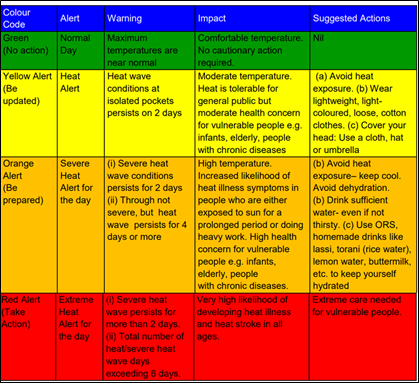

17th April 2023 (7 Topics)
Context
The India Meteorological Department (IMD) on Sunday issued a heat wave warning for West Bengal, Bihar, and Andhra Pradesh over the next four to five days.
What is Heatwave?
- A Heat Wave is simply, a continuous spell of abnormally hot weather.
- Heat waves need not be considered till the maximum temperature of a station reaches at least 40º C for Plains and at least 30º C for Hilly regions.

India and Heatwave:
- Criteria for declaring Heat Wave: A heat wave is considered if the maximum temperature of a station reaches at least 40 degree Celsius or more for Plains and at least 30 degree Celsius or more for Hilly regions.
- Period of Heat Wave in India: Heat waves generally occur over plains of northwest India, Central, East & north Peninsular India from March to June.
- Heatwave-prone states: It covers Punjab, Haryana, Delhi, Uttar Pradesh, Bihar, Jharkhand, West Bengal, Odisha, Madhya Pradesh, Rajasthan, and Gujarat, parts of Maharashtra & Karnataka, Andhra Pradesh and Telangana. Sometimes it occurs in Tamil Nadu & Kerala also.
- Favourable conditions for Heatwave:
- Transportation / Prevalence of hot dry air over a region
- Absence of moisture in the upper atmosphere
- The sky should be practically cloudless
- Large amplitude anticyclonic flow over the area.
|
Different standards for heatwaves Several countries have adopted their own standards for heatwaves:
|
Impacts on India
- Health effects: Hyperthermia, also known as heat stroke, becomes common during periods of sustained high temperature and humidity.
- Mortality: Heatwaves have killed more than 17,000 people in 50 years in India, according to a research study by IMD scientists.
- Crop losses: heat waves and excessive heating impact the standing crops of the regions, as they are not immune to more heat at that time of the year.
- Psychological and sociological effects: In addition to physical stress, excessive heat causes psychological stress, to a degree which affects performance, and is also associated with an increase in violent crime.
- Increase in surface ozone: ozone pollution in urban areas is especially concerning with increasing temperatures, raising heat-related mortality during heat waves. During heat waves in urban areas, ground-level ozone pollution can be 20% higher than usual.
- Lead to wildfires: If a heat wave occurs during a drought, which dries out vegetation, it can contribute to bushfires and wildfires.
- Power outages: Heat waves often lead to electricity spikes due to increased air conditioning use, which can create power outages, exacerbating the problem.
More Articles

